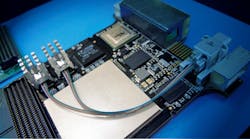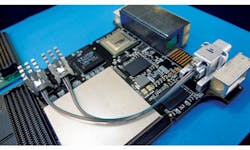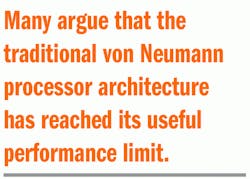This file type includes high-resolution graphics and schematics when applicable.
Making predictions for the upcoming year is always a reasonably educated guess at best. One tries to understand the factors that might influence how the year might go. President Donald Trump is such a wildcard that all bets are off for 2017! The Trump administration’s candidates for key cabinet positions are bound to have an influence on our industry. Trying to understand the impact of Trump and the various names for these positions is mind-numbing. We could see anything from significant investment in our infrastructure and defense spending to never-ending negotiations to rewrite budgets and contracts.
For the second year in a row, a significant number of companies joined VITA. Nineteen companies entered our ranks, driven primarily by activities within the VPX, FMC+, and VITA 49 VITA Radio Transport working groups. Each of these teams was busy adding new elements to the body of standards already in existence.
The VITA Standards Organization is collecting inputs for updates to its technology roadmap to ensure that the needs of the next generation of critical and intelligent embedded computing platforms will have the best possible open architectures supported by open standards.
On the technology front, VITA efforts are likely to be influenced by several trends. Let’s recap the biggest influences.
Global Defense Spending on the Rise
U.S. military spending the past two to three years has been relatively stable. While I don’t foresee any major shift in strategies or spending, it’s difficult to predict what the new Trump administration might do to the defense budget. The Trump business acumen could say let’s renegotiate the budget while the Trump “Build a Wall” persona may throw additional funds into the defense budgets.
Global spending on defense is where the action is right now. The unrest in the Middle East paired with global power positioning by China, Russia, and the United States are keeping the cash flowing for defense spending around the world. Comments from Trump about NATO members needing to step up their commitment to the defense efforts will likely influence more spending by the member countries. The question from our industry is what embedded computing technology is going to be needed.
Regardless, critical embedded and intelligent technology will continue to be focused on intelligence systems, drones, and autonomous weapon systems.
Optical Interconnect Baby Steps
The family of VITA 66 standards (see “VPX Moves Forward With OpenVPX And Additional VITA Specs”) for optical interconnection with VPX is now published. For now, the VPX community is satisfied with the options they have for optical interconnects as defined by VITA 66 (see figure), but they also realize that more is needed.
Presentations on anything optical related at a VSO meeting always gets a good crowd. The discussions about the next steps are still a whisper, but they’re getting louder and more frequent. I feel a bit like a broken record, but you can see the innovation wheel slowly starting to turn in this area.
Mezzanine Blade Performance
The FMC+ (VITA 57.4) working group is taking a bit longer to complete the standard; however, the work done has added substantially to the quality of the standard. The list of participating companies has grown significantly, with major FPGA and user companies stepping up to join the effort. The performance improvements are leading to enhancements to the VPX roadmap. The FMC+ standard should be published early in 2017.
High-End Embedded Processors
As expected, 2016 was full of product announcements using various 6th Generation Intel Core processors. The Intel Architecture is the primary choice in the industry; the processor and related chipset make it difficult for designers to differentiate their single-board computers (SBCs).
To set themselves apart, SBC suppliers are getting more creative with cooling alternatives on small 3U and 6U form factors, now implementing several variations of Intel Xeon class processors that use 85+ W of power. Several cooling schemes are now being implemented with VPX: air, conduction, air flow-through, and air flow-by. Liquid cooling is bantered about, but has not been practically implemented in many systems—yet.
Many argue that the traditional von Neumann processor architecture has reached its useful performance limit. The bottlenecks to memory and I/O are becoming extremely difficult to overcome, forcing many system-level architectures to incorporate FPGAs in the data stream so that processing can be taken to the data. For many types of applications, this is a preferred way to increase performance. Make note of the fact that Intel bought Altera, foreshadowing what we might expect in the near future for processors and integrated programmable logic.
Quantum computing exploits the bizarre and counterintuitive way that matter behaves at an atomic level to perform some amazingly fast processing. First-generation quantum processors are in action now. Quantum computing is especially interesting in the search for more secure computing due to the ability of quantum computers to factor very large numbers that support highly challenging encryption algorithms. The more practical implementation of quantum computers will be in searching and mining the massive amounts of data that we’re collecting each day.
All of this indicates a quickly approaching inflection point that’s going to put past thinking about processors on its ear.
Semiconductor Supplier Mergers
Mergers are reshaping the semiconductor supplier industry, having potential impact on high-end embedded processor roadmaps. The Qualcomm purchase of NXP will likely throw yet another curveball at PowerPC, bringing back into question its viability in the critical embedded-computing industry.
The SoftBank Group Corp. purchase of ARM Holdings plc is likely to change in some form the direction of ARM. While the plan of record is to continue the current course, we all know how that story tends to play out. I remain bullish on ARM-based processors as an emerging major player in the critical embedded-computing markets, but the lower-end Internet of Things (IoT) markets have control of the roadmap. My biggest concern is what effect this activity is going to have on processor innovation. It makes me take a harder look at some of the more “out-there” options like quantum processors.
Summary
I’m going to stick my neck out and speculate that a president with a business background and no political experience is just what we need right now. Having a supportive Republican congress may get some beneficial legislature passed in the coming years. If a few successes can be knocked out early, the ball might get rolling quickly. A stronger international presence could get some of the lingering issues off our plate. On the other hand, we could be searching for a new president as soon as 2018. Someone just needs to disable Trump’s Twitter account! Meanwhile, I’m shopping for property in Australia!






